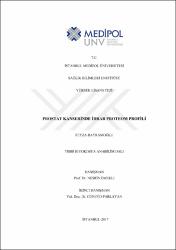| dc.contributor.advisor | Emekli, Nesrin | |
| dc.contributor.advisor | Parlayan, Cüneyd | |
| dc.contributor.author | Bayramoğlu, Feyza | |
| dc.date.accessioned | 2021-06-08T08:40:24Z | |
| dc.date.available | 2021-06-08T08:40:24Z | |
| dc.date.issued | 2017 | en_US |
| dc.date.submitted | 2017-01-13 | |
| dc.identifier.citation | Bayramoğlu, F. (2017). Prostat kanserinde idrar proteom profili. (Yayınlanmamış yüksek lisans tezi). İstanbul Medipol Üniversitesi Sağlık Bilimleri Enstitüsü, İstanbul. | en_US |
| dc.identifier.uri | https://hdl.handle.net/20.500.12511/7086 | |
| dc.description.abstract | Kompleks analiz sistemlerinin yer aldığı proteom çalışmalarında idrar analizi ile ilgili olası sınırlılıklar, olumsuzluklar ve sonuçlar günümüzün önemli teknik konuları arasında yer alır. Bazı klinik olgular ve sağlıklı kişilere ait biyolojik sıvılardaki mikro düzeyde ve çok sayıda proteinin aynı anda karşılaştırıldığı proteomik analizler günümüzde hastalığa spesifik biyobelirteç bulunmasında etkin bir yöntem olarak kabul edilmektedir. Bu çalışmanın amacı prostat kanserli (PCa) hastaların idrarlarında kontrol grubu ile birlikte proteom analizi yapmak, farklı teknikleri denemek, olası protein farklılıklarını tespit etmek ve daha ileride yapacağımız biyobelirteç çalışmalarına temel oluşturmaktır. Numune hazırlama aşaması idrar proteomiksi çalışmalarında çok önemli bir basamaktır. Bu sebeple çalışmamızda kullanabileceğimiz en iyi metoda karar verebilmek için sağlıklı insan idrarında 2 farklı peptidlerine ayırma metodu kullanıldı. FASP kiti ile peptidlerine ayrılan numunede 372, In-sol protokolüne göre çalışılan numunede ise 26 protein tanımlandı. Normal bir insan idrarının protein konsantrasyonu oldukça düşüktür ve proteomik analizleri engelleyen tuz konsantrasyonu ise oldukça yüksektir. Bu sebeple en efektif tuzları uzaklaştırma metodunu bulmak amacıyla idrar örneklerine, numune hazırlama aşamasında aseton presipitasyonu ve diyaliz uygulanarak sırasıyla 52 ve 10 protein tanımlandı. Ön çalışmalarımızdan elde edilen bu sonuçlar doğrultusunda asıl deney setimizi oluşturan prostat kanserli hasta ve kontrol idrarlarına aseton presipitasyonu ve FASP uygulandı. PCa grubunda 10 ve kontrol grubunda ise 5 protein tanımlandı. Her bir metodun birbirleriyle kıyaslandığında avantajıları ve dezavantajları vardır. Tüm idrar proteomunun incelenmesini sağlayacak tek bir mükemmel protokolün olmadığı bilinmektedir. Bu çalışma sonucunda en büyük miktarda ve kalitede veri elde edebilmek için birkaç numune hazırlama metodunun birlikte kullanılması gerektiği sonucuna ulaşılmıştır. | en_US |
| dc.description.abstract | Possible limitations, disadvantages and consequences of the urine analysis in proteomics studies which include complex analysis systems are among the most important technical issues of today. Proteomic analyzes at the micro level of the biological fluids of the healthy persons with respect to the some clinical cases in which a large number of proteins are compared at the same time are now considered to be an effective method for the detection of disease-specific biomarkers. The aim of this study is to perform proteomic analysis in the urine of patients with prostate cancer (PCa) with our control group, to try different techniques, to detect possible protein differences, and to provide a basis for our biomarker studies to be exercised. The sample preparation stage is a very important step in the study of urine proteomics. Therefore, two different peptide separation methods have been used in a healthy person urine in order to determine the best method for our study. While 372 proteins have been identified with the FASP kit, 26 proteins have been identified in the sampling study according to the sol protocol. The protein concentration of a normal person urine is very low and the salt concentration blocking the proteomic analysis is quite high. For this reason, urine specimens were subjected to the aceton precipitation and dialysis during the sample preparation phase for the purposes of finding the most efficient method of removing the salts. 52 and 10 proteins were identified, respectively. Aceton precipitation and FASP were applied in accordance with these results obtained from our preliminary studies to the patients with prostate cancer and urine samples of our control group, which form our main experiment set. 10 proteins are identified in the PCa group and 5 proteins in the control group. The relative efficacy of these different methods in terms of quality and recovery yield is still not sufficient. Each method has both its advantages and disadvantages when compared to each other. We know there is not a single perfect protocol to analyse all urine proteomics. As a result of this study, we have reached the conclusion that several sample preparation methods must be used together to obtain the largest amount and quality of data. | en_US |
| dc.language.iso | tur | en_US |
| dc.publisher | İstanbul Medipol Üniversitesi Sağlık Bilimleri Enstitüsü | en_US |
| dc.rights | info:eu-repo/semantics/openAccess | en_US |
| dc.subject | Aseton Presipitasyonu | en_US |
| dc.subject | Diyaliz | en_US |
| dc.subject | FASP | en_US |
| dc.subject | In-Solution | en_US |
| dc.subject | Proteomiks | en_US |
| dc.subject | Prostat Kanseri | en_US |
| dc.subject | Proteomics | en_US |
| dc.subject | Aceton Precipitation | en_US |
| dc.subject | Dialysis | en_US |
| dc.subject | FASP | en_US |
| dc.subject | In-Solution | en_US |
| dc.subject | Prostate Cancer | en_US |
| dc.title | Prostat kanserinde idrar proteom profili | en_US |
| dc.title.alternative | Urine proteom profi̇le i̇n prostate cancer | en_US |
| dc.type | masterThesis | en_US |
| dc.department | İstanbul Medipol Üniversitesi, Sağlık Bilimleri Enstitüsü, Biyokimya Ana Bilim Dalı | en_US |
| dc.relation.publicationcategory | Tez | en_US |


















